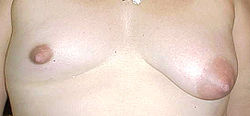| Anisomastia | |
|---|---|
| Specialty | Plastic surgery |

Anisomastia is a medical condition in which there is a severe asymmetry or unequalness in the size of the breasts, generally related to a difference in volume. [1] In other words, when one of the breasts is much larger than the other. [2] In contrast to anisomastia, a slight asymmetry of the breasts is common. [1] Anisomastia may be corrected by surgical breast augmentation or reduction. [3]